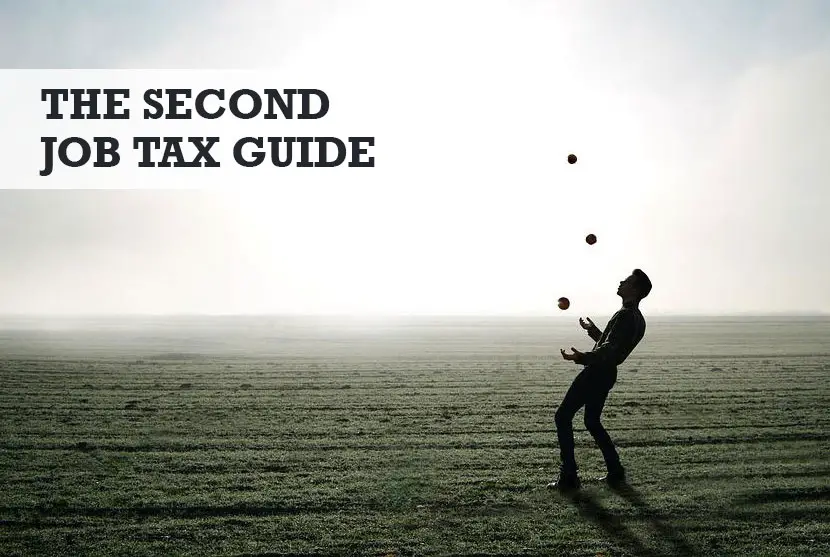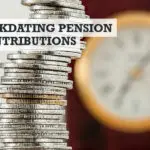With the cost of living rising and uncertainty over the economy, more people are looking to take on second jobs to supplement and boost their income. However, some will wonder whether a second job is worth it once tax is paid.
We’ve written this guide to second job tax which explains how much you get taxed on a second job, how to tell HMRC you have two jobs, National Insurance contributions, and how it will affect your tax code.
As with most things when it comes to tax in the UK, there is no standard answer to those asking whether they pay more tax if they have 2 jobs, but it is possible to calculate it for yourself – here’s the short answer first.
How much do you get taxed for a second job? How much a second job affects tax will depend on your personal circumstances. If you’re working, you’re entitled to earn a certain amount of money without paying Income Tax on a second job. This is called the Personal Allowance and is £12,570 for the 2022/23 tax year.
You only get one Personal Allowance – so it’s usually best to have it applied to the job paying you the most – whether that’s the second job or the first job.
We appreciate that’s not the clear-cut answer you need, but if you read on below, we have some useful examples and second job tax calculators for you.
How much do you get taxed on a second job?
Working out how much you will get taxed on a second job is the best way of deciding whether it’s worth working a second job.

There are various second job tax calculators online, and the HMRC also have tools to help you crunch the number – all below.
1. Independent second job tax calculator
It is possible that you will pay more tax if you have 2 jobs. But hopefully that won’t be the case and it will be worth taking on extra employment.
You can work out the tax on your second job with this calculator – it’s important to get this calculation correct.
Working out the tax on a second job may make all the difference to whether it is worth taking on the extra role.
- You can use the Two Jobs Calculator from thesalarycalculator.co.uk
You can use the two jobs calculator on the link above to see what happens to your total take-home and tax when you take a second job. To get started, enter your annual salary from your first job and the salary from the second job.
2. HMRC second job tax calculator
The HMRC can also help you decide whether working two jobs will affect your tax return.
HMRC provide a calculator for working out your income tax for the tax year. You will need to add together all your incomes to use this tool.
This tells you your take-home pay if you do not have any other deductions, such as pension contributions or student loans. If you wish to use something more comprehensive to get a full picture, we recommend using the two jobs calculator above.
3. Self-employed second job tax calculator
If you’re working your second job as self-employed, you’ll need to:
- Register as self-employed with HMRC.
- File a Self-Assessment tax return by 31 January each year.
- Pay your own tax and National Insurance contributions.
As you’re self-employed, you won’t get a payslip. So, you’ll have to be careful about your tax code on your other job.
Usually, the job paying you the most should be classed as your main job.
However, if your second job is self-employed you might not know exactly how much you’re earning. This makes it potentially difficult to make sure your full Personal Allowance is being taken.
If both jobs are paying you below the Personal Allowance, you’re still entitled to split your allowance between them.
If one of your jobs is self-employed, you’ll pay tax and National Insurance contributions a year in arrears.
For example, for the money you earned in the 2021/22 tax year, you’ll need to pay the outstanding tax and National Insurance contributions by 31 January 2023.
This means it’s important you think about how you’ll pay what could be a substantial bill. The good news is, that you should have an idea about how much tax you’ll owe at the end of the previous tax year. This gives you nine months to prepare.
- You can quickly calculate how much income tax and national insurance you owe on your earnings if you’re both employed and self-employed using this self-employed second job tax calculator from taxscouts.com
What about tax on second job under 16 hours?
For those wondering about the tax on a second job under 16 hours, you need to consider the following: The number of hours you work in a second job is not the driver of the how much tax you will pay overall.
With tax, there is a single tax-free amount available per person per tax year.
The standard tax-free allowance for 2022/23 tax year is £12,570 meaning you can earn £12,570 income in the year before you start paying tax.
The amount you earn in your second job is therefore the figure that drives the tax on your second job.
If you work two jobs under 16 hours, you might not use your personal allowance fully in either job.
You can contact HMRC and get them to transfer any unused allowance from your main job to your second job. Or you can wait until the end of the tax year and ask HMRC for a refund.
Is a second job worth it?
So, based on all that we now know, is it worth working a second job?
Understand that taking a second job can affect your tax credits or other benefits. So, you will need to work out how much extra you’ll be earning.
If you’re claiming Universal Credit, and aren’t getting the work allowance, your payment will go down 63p for every £1 earned.
If you’re still claiming Working Tax Credit, you’ll need to tell the Tax Credit Office if your income changes by more than £2,500. But this might count as a change in circumstances and could mean you have to make a new claim for Universal Credit.
Ultimately only you can decide if a second job is worth it considering a range of factors such as the financial benefit of taking the second job versus the time you have available for family.
Do you pay National Insurance on a second job?
When calculating how much tax you pay on a second job, you should also consider National Insurance. As well as income tax, you might have to pay some National Insurance contributions (NIC) on the income from a second job.
However, National Insurance operates in a different way from income tax. With tax, there is a single tax-free amount available per person per tax year. For National Insurance there is a new limit for each job so long as it is with a different employer.
The standard tax-free allowance for 2022/23 tax year is £12,570. This is the amount you can earn before paying tax in the tax year regardless of the number of jobs you have.
How that tax-free allowance is split between your jobs via your tax code will determine how much you get taxed on a second job as well as the income from that job.
If you earn above £190 a week in the 2022/23 tax year, you’ll have to pay Class 1 National Insurance contributions.
If you earn more than this in both of your jobs, you’ll pay National Insurance contributions on both jobs.
In the Spring Statement in March 2022, the then Chancellor of the Exchequer, Rishi Sunak, announced that from 6 July 2022 there would be an increase in the primary threshold, the level at which an employee becomes liable to pay Class 1 National Insurance contributions, as part of the Government’s measures to assist in reducing the cost of living.
The increase has been aligned with the UK personal allowance, so has risen from the original primary threshold of £9,880 per year up to £12,570.
This means if you earn above £242 a week from 6 July 2022/23 tax year, you’ll have to pay Class 1 National Insurance contributions. At the same time as lifting the limit, the Class 1 National Insurance contributions amount was lifted to 13.25% from 12%.
You could in fact be better off by having two part-time jobs under the threshold than one full-time job above the threshold.
You can estimate how the change to National Insurance will affect you using the HMRC calculator.
Second job tax examples
You only get one Personal Allowance – so it’s usually best to have it applied to the job paying you the most.
If you work two jobs and neither income is above £12,570, you can split your Personal Allowance.
Example 1 – two jobs
Dave works two jobs. His main job pays £14,000 a year, and the second £6,000.
His whole Personal Allowance is applied to his main job. If he lives in England, Wales, or Northern Ireland, he pays Income Tax at the basic rate of 20% on the £1,430 of his pay that’s above the allowance for his main job – and on all his income from her second job.
Example 2 – two jobs below the Personal Allowance
Kerry has two jobs. Her main job pays £10,000 a year and his second £9,000.
Both are below the Personal Allowance, so she can split his allowance between the two jobs.
She can contact HMRC and get them to transfer £2,570 of unused allowance from her main job to her second job. Or she can wait until the end of the tax year and ask HMRC for a refund.
You should only ask for your Personal Allowance to be split if your income from each job is predictable and stable. If it’s not, and one job ends up paying you more than expected, you’ll have underpaid tax.
Example 3 – combined earnings over £50,000
Gemma’s main job pays her £45,000 a year. But she also has a part-time job paying £12,000 a year. This means she has a total income of £57,000, with all her Personal Allowance being applied to her main job.
Unless Gemma tells HMRC this, her second job will be taxed entirely at the basic rate, when some of it should be taxed at the higher rate.
If she doesn’t tell HMRC this, she’ll have to pay extra tax at the end of the tax year.
If Gemma is claiming Child Benefit, she may have to pay a tax charge, known as the ‘High Income Child Benefit Charge’, if you have an individual income over £50,000 and either:
- You or your partner get Child Benefit.
- Someone else gets Child Benefit for a child living with you and they contribute at least an equal amount towards the child’s upkeep.
It does not matter if the child living with you is not your own child.
FAQs on how much you get taxed for a second job
How much tax do you pay for a second job?
It’s important to check your tax codes. This will help make sure you’re paying the right amount of tax and don’t get unexpected tax bills, penalty charges and interest.
Your main job, assuming it pays you more than the Personal Allowance, should be 1257L for the 2022/23 tax year.
Your second job should have a BR, D0 or D1 tax code, depending on whether it’s taxed at the basic, higher, or additional rate.
You can find your tax code on your payslips.
How do I tell HMRC I have two jobs?
You can tell HMRC about starting a second job using the new starter checklist from your new employer.
Do I pay more tax if I have two jobs?
How much you get taxed on two jobs should be the same as if you have one job with the equivalent total salary.
As you have one personal tax allowance of £12,570 and tax is based on cumulative calculations across the tax year regardless of the number of jobs you have you should not be any better or worse off from a tax point of view.
Conclusion
If you are investigating how much a second job affects your tax, then you have a lot going on. Taking on the extra burden of a second job and guessing how much extra you are going to take home is not something you should do lightly.
To keep things simple use one of the second job tax calculators we have included in this guide to help you determine what works for you.
If you make a mistake it could end up costing you in the form of an unexpected tax bill negating the purpose of having a second job in the first place.
Take your time to work through different scenarios so you can be confident about what works for you and your family situation.
You can see from the examples provided that going over £50,000 will have a detrimental effect on Child Benefit payments, this can easily sway your decision-making process.
You might also like…
Image in header via https://pixabay.com/photos/juggler-trick-magician-juggle-1216853/

Jon has been in business since 1999, and in that time worked with more than 300 small business clients. As well as being an accountant, he is also an early adopter of tech, and has helped small businesses to leverage the power of their computer systems by creating software to automate and simplify accounting tasks.






